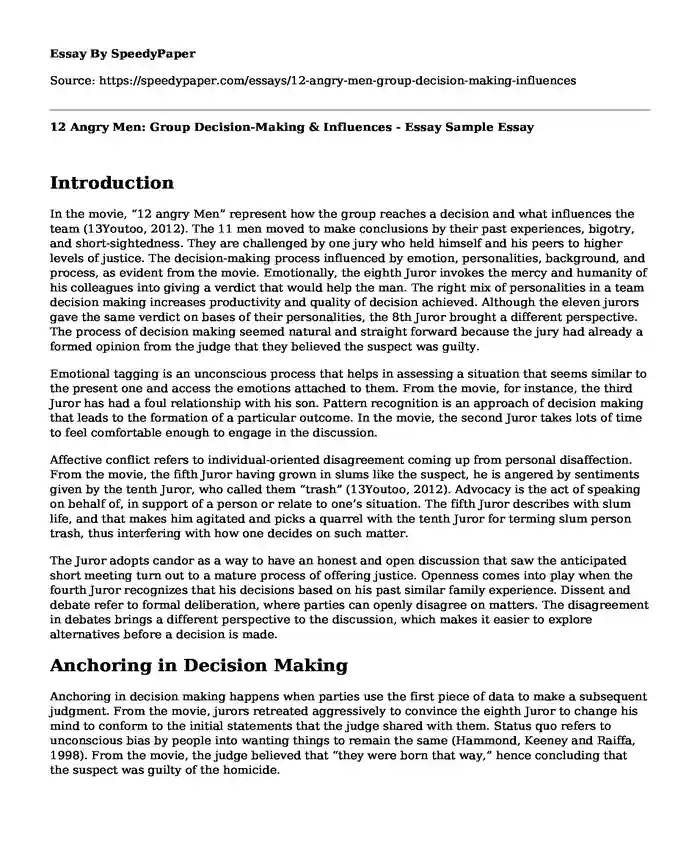
| Type of paper: | Essay |
| Categories: | Movie |
| Pages: | 3 |
| Wordcount: | 646 words |
Introduction
In the movie, “12 angry Men” represent how the group reaches a decision and what influences the team (13Youtoo, 2012). The 11 men moved to make conclusions by their past experiences, bigotry, and short-sightedness. They are challenged by one jury who held himself and his peers to higher levels of justice. The decision-making process influenced by emotion, personalities, background, and process, as evident from the movie. Emotionally, the eighth Juror invokes the mercy and humanity of his colleagues into giving a verdict that would help the man. The right mix of personalities in a team decision making increases productivity and quality of decision achieved. Although the eleven jurors gave the same verdict on bases of their personalities, the 8th Juror brought a different perspective. The process of decision making seemed natural and straight forward because the jury had already a formed opinion from the judge that they believed the suspect was guilty.
Emotional tagging is an unconscious process that helps in assessing a situation that seems similar to the present one and access the emotions attached to them. From the movie, for instance, the third Juror has had a foul relationship with his son. Pattern recognition is an approach of decision making that leads to the formation of a particular outcome. In the movie, the second Juror takes lots of time to feel comfortable enough to engage in the discussion.
Affective conflict refers to individual-oriented disagreement coming up from personal disaffection. From the movie, the fifth Juror having grown in slums like the suspect, he is angered by sentiments given by the tenth Juror, who called them “trash” (13Youtoo, 2012). Advocacy is the act of speaking on behalf of, in support of a person or relate to one’s situation. The fifth Juror describes with slum life, and that makes him agitated and picks a quarrel with the tenth Juror for terming slum person trash, thus interfering with how one decides on such matter.
The Juror adopts candor as a way to have an honest and open discussion that saw the anticipated short meeting turn out to a mature process of offering justice. Openness comes into play when the fourth Juror recognizes that his decisions based on his past similar family experience. Dissent and debate refer to formal deliberation, where parties can openly disagree on matters. The disagreement in debates brings a different perspective to the discussion, which makes it easier to explore alternatives before a decision is made.
Anchoring in Decision Making
Anchoring in decision making happens when parties use the first piece of data to make a subsequent judgment. From the movie, jurors retreated aggressively to convince the eighth Juror to change his mind to conform to the initial statements that the judge shared with them. Status quo refers to unconscious bias by people into wanting things to remain the same (Hammond, Keeney and Raiffa, 1998). From the movie, the judge believed that “they were born that way,” hence concluding that the suspect was guilty of the homicide.
The Sunk Cost
The sunk cost is a mental shortcut that faces a person who invests their time and emotions in a losing endeavor. Framing is a trap that comes with how a question or situation is first presented. Before the case, the judge had already placed judgment on the suspect. Recallability is a trap whereby a decision can be compromised because of our exaggerated or underrated imaginations about a particular activity. From the movie, both the fourth and eighth Jurors felt that they had a similar knife to the one the boy perceived to have used against his father.
References
Hammond, J. S., Keeney, R. L., & Raiffa, H. (1998). The hidden traps in decision making. Harvard Business Review, 76(5), 47-58. https://hbr.org/1998/09/the-hidden-traps-in-decision-making-213
Youtoo (7 June 2012) 12 Angry Men (Video). YouTube. https://www.youtube.com/watch?v=ngbEpZ0tTjI&t=109s
Cite this page
12 Angry Men: Group Decision-Making & Influences - Essay Sample. (2023, Sep 16). Retrieved from https://speedypaper.net/essays/12-angry-men-group-decision-making-influences
Request Removal
If you are the original author of this essay and no longer wish to have it published on the SpeedyPaper website, please click below to request its removal:
- Paper Sample on Media's Representation of African-Americans Case Studies
- Essay Sample on Negative Stereotype Promoted by the Film Coming to America
- Free Essay: Diary of a Shinjuku Thief
- Trump is a Dangerous Media Mastermind - Essay Example
- Social Media Connects: Analyzing 3 Wall Posts from WHO, Entrepreneur, and Student - Essay Sample
- Breaking Stereotypes: Unveiling Gender Biases in America's Got Talent - Essay Sample
- "Letter from Heaven" Analysis: Heartfelt Short Film on Promises and Connections - Free Paper
Popular categories




